Do-it-yourself stove stove: a scheme of a home-made stove for a summer house and garage
Often, homeowners prefer to assemble simple and useful home-made products from improvised and unnecessary materials, instead of buying the finished one. And a potbelly stove is one of such useful devices.
The main feature of the potbelly stove is that it heats up as quickly as it cools. Therefore, the scope of its use is narrowed mainly to those rooms where it is necessary to provide fast heating, while the appearance of the device is often completely unimportant for the user.
A do-it-yourself stove can be made, and, if desired, upgraded to achieve more efficient heat transfer.
You also thought about assembling such a homemade product and do not know where to start? We will help you in the implementation of the task - the article discusses the assembly procedure for various versions of the homemade furnace, provides drawings and diagrams.
Also discussed in detail ways to improve a homemade stove, as a result of which the efficiency of the stove will be significantly higher.
The content of the article:
How to make a potbelly stove: device and schemes
The choice of furnace design depends on what material is used as fuel. Each user himself determines the degree of its availability and economic feasibility.
It is a combustible material, which has a different temperature and the nature of combustion, dictates the principles of creating various modifications of the device.
The shape of the potbelly stove can be different, often it depends on the availability of suitable material. It can be an old can, a gas cylinder, a metal container - all that is at hand. The main thing when choosing it is the metal thickness and shape, which requires a minimum of alterations.
Waste Oil Stove
Used engine oil is a multicomponent, slightly flammable substance, which, to be burned, must first be broken down into simple constituents. For this, the method of pyrolysis or flame separation is used, in which fuel is heated and evaporated.
To do this, light a fire with a rag dipped in gasoline or kerosene. Fuel, when heated, is split into simpler flammable substances. Further, the pyrolysis combustion process supports itself.
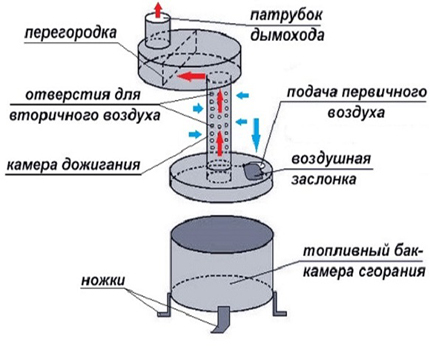
Phased job description
The manufacture of potbelly stoves on waste oil is carried out in the following sequence:
- They take two pieces of pipe with a height of 100 and 115 mm, a diameter of 350 mm - they will serve as the basis for the creation of two chambers.
- A bottom and a cover with holes are welded to the ring with a higher height: the first with a diameter of about 100 mm under the pipe; the second is small in size for air intake. For a blower, a shutter is made from a mug of a slightly larger diameter.
- In the pipe, which is mounted on top of the fuel compartment, drill evenly along the entire length of the hole.
- A second chamber is made with openings for a chimney and a secondary combustion pipe. Inside, a partition is made of a rectangular sheet of metal.
- A chimney is installed on top, legs are welded to the base.
The design of a cylindrical two-volume boiler at the workout ensures high temperature and complete combustion of fuel. Instead of cylindrical, you can use rectangular chambers.
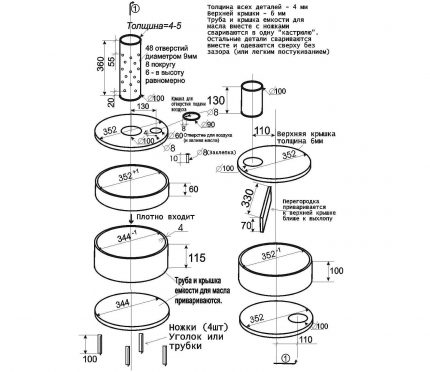
The principle of operation of the furnace
In the lower tank, potbelly stoves pour fuel through a small hole. At the same time, it serves as an evaporator and primary combustion chamber. A small hole in the lid is also intended for ignition, air supply and adjustment of its flow (using the damper).
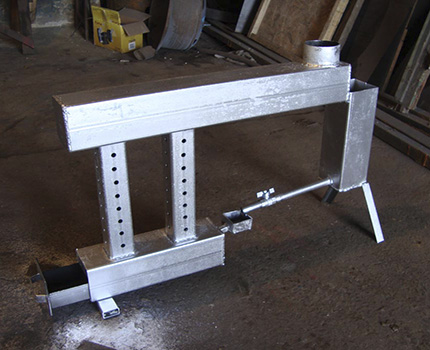
A pipe with holes installed in the first compartment serves as a secondary afterburner - pyrolysis decomposition of fuel occurs in it, which evaporates due to heating in the first chamber.
The next cylindrical tank is equipped with an internal partition to reduce the speed during the movement of combustion products, providing an increase in the degree of oxidation of nitrogen compounds. At the same time, it serves as an infrared and convection heater.
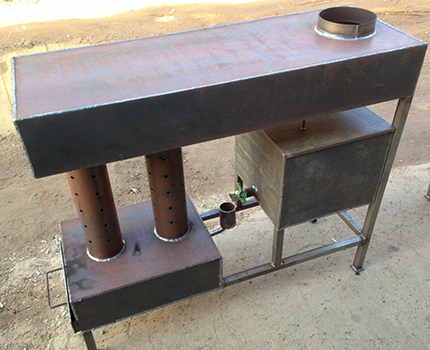
It is in the stoves for the garage that they most often use mining as fuel. Of all the heating devices, it is one of the most dangerous.
If someone decides to violate fire safety rules and make a stove on their own, it is better to allocate a separate room for the boiler room or fence it off with a brick wall.
On our site there are other materials for the manufacture of stoves for waste oil:
- The furnace for working out of the pipe: how to make an effective furnace for used oil from improvised materials
- How to make a potbelly stove on waste oil with your own hands: options and examples of making a stove
- DIY garage oven: the best examples of making homemade products
- Do-it-yourself garage oven: a step-by-step guide to design
Solid fuel stove
Firewood, brick, coal - this is so far the most affordable and economical fuel material. Its use is the least safe, which means that the stove working on such fuel is the easiest to do.
There are a lot of options for various modifications of bourgeois made by hand. Consider the most common models.
Cylinder and barrel stove
An old gas cylinder made of thick-walled metal is suitable for any type of fuel, including coal. A simple design will cope with the task of quickly warming up the room, but as soon as the flow of fuel stops, it will quickly cool down.
Homemade cylinder stove compact, has a neat appearance. Such a potbelly stove is used for a summer residence, a makeshift, garage.
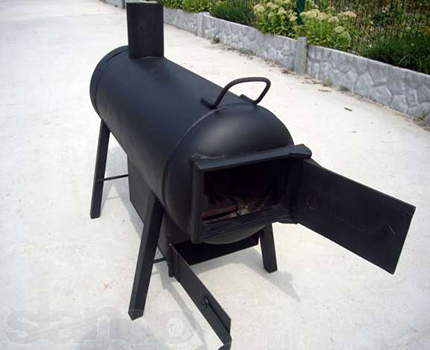
In order to make a furnace from a gas cylinder, it is necessary to cut openings for the door and under the chimney in the case. The cut metal sections will serve as doors after the curtains and the locking mechanism are welded to them. For air to enter the furnace, the door below is drilled through.
A detailed description of the manufacturing process of a makeshift chimney for a potbelly stove we examined in another article.
In the lower part of the chamber, a grate from the grate is placed (it can be welded from reinforcement), under which ash will accumulate. A hob can also be arranged. It is easier to do this on a horizontally located cylinder by welding corners on it from two sides.
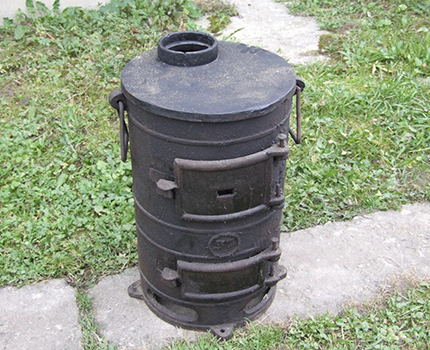
A gas pot made from a gas cylinder can also be used as the basis for the further construction of a hot water column, as it is also called - "Titan". To do this, a stainless tank is installed over the stove, through which a chimney pipe passes.
Water in a wood-burning boiler heats up quickly, and firewood is used little - in the summer one bookmark in a small firebox is enough.
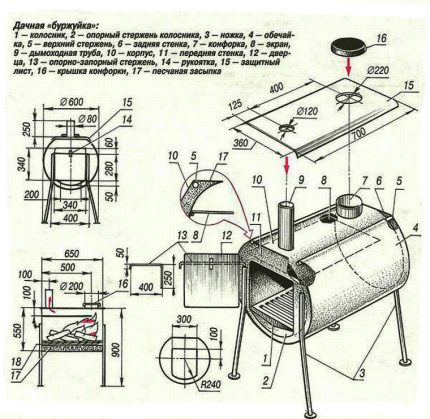
For a potbelly stove, a metal container with walls at least 3 mm thick is also suitable. The open top of the tank is closed with a circle of metal sheet and brewed.
A hole for the chimney is cut out in the lid or wall. Its diameter should be at least 100-150 mm. The top in such a stove will heat up so much that it will be possible to cook food on it, warm the water.
On our site there is also a more detailed instruction with diagrams and drawings for manufacturing gas bottle pots.
Features potbelly stove on sawdust
If there is no shortage of sawdust on the farm, then this type of fuel will justify its use.Such a potbelly stove does not require frequent loading - tamped sawdust inside does not burn, they smolder slowly, releasing thermal energy gradually and providing heat for a long time.
We recommend that you see information on how to make sawdust briquettes do it yourself.
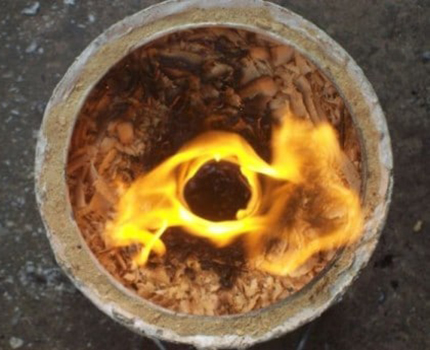
The basis of the furnace can be a metal barrel with an open top (if the container is tight, then the top is cut off) or a pipe with a diameter of 300 to 600 mm.
Then, a metal circle is cut from a sheet with a thickness of three or more millimeters, which should be smaller than the inner diameter of the barrel. In its middle, a hole with a diameter of 100 mm is cut under the cone for ramming sawdust.
The workpiece is welded to the walls of the barrel. With the help of this circle, an ash pan is fenced - in it, using chips or chips, ignition will be carried out. The height of the ash pan should be 100-200 mm.
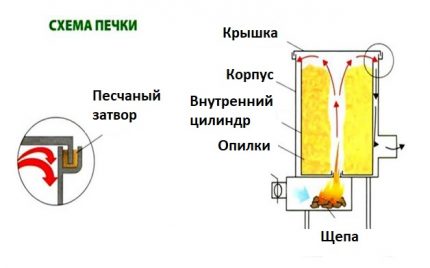
A window is cut below the welded circle, which will serve as a blower. The curtains are welded to the cut metal piece, making a door for the same hole.
In the lid of the tank make an exit to the chimney. The lid should fit tightly on the potbelly stove and be from a sufficiently thick sheet, otherwise it will quickly burn out.
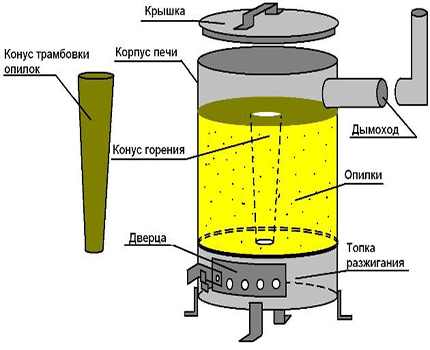
You can improve the same model by adding an additional cylinder. In this embodiment, the sawdust will be in the inner chamber, and the space between the two compartments will serve to burn gases and increase the heating area. In this embodiment, the exit of flue gases is arranged in the lower part of the stove.
How can you improve a potbelly stove?
An ordinary potbelly stove has a lot of positive qualities, but also has many significant drawbacks. She is unable to accumulate heat and heats the room while the fire is burning. It requires a continuous supply of fuel, on average - every 30-40 minutes.
In addition, a large amount of heat flies through the chimney into the atmosphere, without any benefit. That is why work on improving the potbelly stove is ongoing.
The standard design of the stove-potbelly stove has many modernized designs that allow you to:
- save fuel;
- increase the efficiency of the stove;
- increase heat capacity;
- reduce the frequency of fueling.
The most common methods for increasing the efficiency of a potbelly stove are the creation of a slow burning mode, a gas afterburning system, and installation of a heat-resistant lining of the inner walls.
You can also improve the quality of the stove by increasing the heat transfer area with the help of welded pipes and an installed fan, which will drive air through them.
The industrial model of such a potbelly stove is called “Buleryan”, but, besides it, there are still many different designs made by the artisanal method. We recommend that you look at a detailed home-made workshop. Buleryan furnaces.
You can increase the heat transfer time if you overlay the stove with brickwork. Such a stove will heat up more slowly, but also give off heat longer, maintaining the temperature in the room for some time after the fire is extinguished.
Are you interested in masonry? We have a detailed guide to masonry stove do it yourself with diagrams and drawings.
Option # 1 - furnace with increased fuel tab
This model is designed to increase efficiency and continuous burning time.As a basis, they take a horizontal rectangular potbelly stove on massive, stable legs and supplement it with a cassette from a deaf sealed cylinder. Such constructive additions significantly increase its effectiveness.
A flange is welded to the cassette cylinder with a height of about 400 mm. After installing the cylinder in the burner hole, its edge should fall 5-10 mm below the stove. To make the cylinder convenient to install and remove, handles are welded to its body.
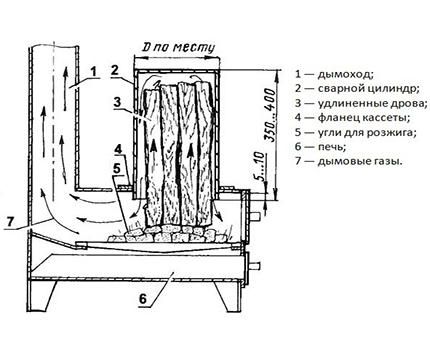
How does a potbelly stove work:
- The lower part of the firewood, dropping to the coals of the preliminary ignition, flares up. In this case, the upper part located in the cassette will not burn due to a lack of oxygen, but it will be dried by the action of hot smoke.
- Under the weight of its own mass and as it burns, the firewood gradually sinks into the firebox.
- Hot gas, which has been in the cylinder for some time, gives off heat to it, thereby increasing the heat transfer area in the room. In this case, the cylinder cover can serve as a hob.
- At the same time, the temperature of the outgoing smoke decreases, which means that the heat capacity and efficiency of the stove are increasing.
As a result of such modernization, the time interval between the laying of firewood increases and the efficiency of using the stove increases.
Option # 2 - a long-burning potbelly stove “Bubafonya”
The low efficiency of an ordinary stove is a long-known fact and verified by many users.
One of the methods for increasing it is to slow down the combustion process by restricting the flow of air into the combustion chamber. This improvement can be found in stoves such as Bubafonya and Filipina.
Use this model of potbelly stoves in non-residential premises - workshops, greenhouses, and other outbuildings. For work within 9-12 hours, one bookmark of small firewood, wood chips, sawdust is enough. In this model of a heating device, coarse-chopped and raw firewood cannot be used.
A potbelly stove can be created from any metal tank. Most often use a barrel of fuel and lubricants or an old bottle.
Production is carried out in the following sequence:
- From an available cylindrical tank, a furnace chamber is prepared, in the upper part of which a hole is cut out for the chimney.
- From metal (at least 10 mm in thickness), a circle is cut out, slightly smaller than the inner diameter of the barrel.
- A hole with a diameter of 100-150 mm is made in the center of the circle (the exact size depends on the diameter of the pipe used for the rod).
- On one of the planes of the circle, ribs up to 50 mm high are welded.
- A pipe is welded to the center of the circle. Its length is calculated so that the piston in the lowered state rises above the tank cap by about 100 mm. If you leave the pipe longer than necessary, draft will occur in it, it will start to smoke.
- Next, construct a cover that will fit tightly on the barrel and cut a hole in it that fits under the piston pipe
You can further increase the efficiency of this model by organizing the intake of air from the street. Thus, the heated air from the room will not fly into the chimney.
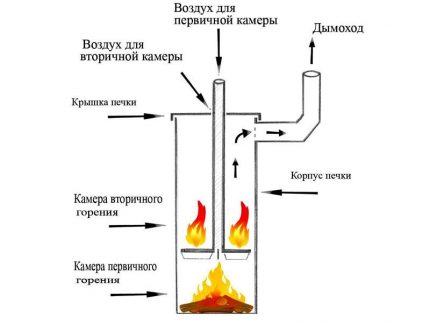
Option # 3 - a furnace with secondary afterburning “Philippine”
The furnace used two methods to increase its efficiency, based on the principles of long burning and pyrolysis. For its manufacture, two gas cylinders will be needed, which will serve as chambers for primary and secondary combustion.
The sequence of steps for making a potbelly stove is as follows:
- Cylinders are prepared for work by releasing gas residues from them and filling them with water.Without this procedure, it is categorically impossible to cut them, otherwise the sparks that are formed during the operation of the grinder can provoke a gas explosion, a certain amount of which always remains in the cylinder.
- In the first cylinder, which will serve as a chamber for the furnace and ash pan, remove the tap and cut off the top (it is used to make the door), cut a hole for the installation of the chimney.
- Opposite the chimney hole, a pipe is welded, the other end of which should not abut the lid of the second chamber, leaving free space for smoke to escape.
- At the exit of the pipe from the first cylinder, a metal ring is welded, it will serve as a support for the installation of the upper cylinder. Holes are drilled in it.
- A metal ring is also welded to the second cylinder at the place of cutting of the top, in which the places for holes are marked, focusing on the already made holes in the first ring.
- Before finally installing the second cylinder, a pipe for supplying air is inserted into it.
- The upper chamber is put on the pipe, combining the holes, a heat-resistant tourniquet is wound between the rings, the connection is fixed with screws.
- The chimney exit is made from the bottom of the secondary afterburner chamber.
To obtain a stable design, reliable legs are welded to the lower chamber. Install the door to the awnings. It can be further improved by adding the ability to regulate the air entering the furnace.
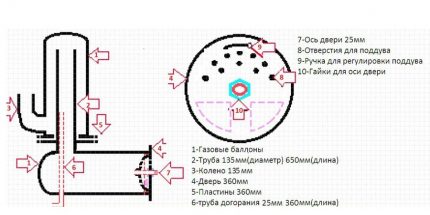
In the first chamber, stoves burn wood, emitting flammable gas. Hot flue gases, falling into the second chamber and mixing with air, light up and completely burn.
With the help of a blower, thrust is regulated, which, after the firewood has flared up well, can be reduced to a minimum in order to reduce the speed of gas movement and heat loss.
Conclusions and useful video on the topic
How to maximize the potential of a potbelly stove in used engine oil:
Improved stove gas stove with a secondary afterburner:
Design and rules for using the Bubafonya furnace for long burning:
When making a homemade potbelly stove, you should not forget about precautions. Its design should protect against the spread of fire.
Neglect of fire safety rules can play a trick on those who want to save on buying an industrial model.
Have you been using a homemade potbelly stove for years? Tell us which scheme you used and what was the most difficult when assembling the stove.
Perhaps you improved your potbelly stove in one of the ways discussed in the article? Share your experience and pictures of the homemade stove in the comments to this article - your success will inspire other users to experiment.

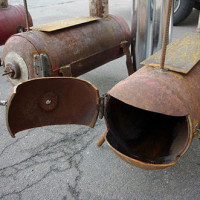 Do-it-yourself gas stove from a gas cylinder: diagrams, drawings + step-by-step guide
Do-it-yourself gas stove from a gas cylinder: diagrams, drawings + step-by-step guide  DIY garage oven: an overview of the best homemade options
DIY garage oven: an overview of the best homemade options 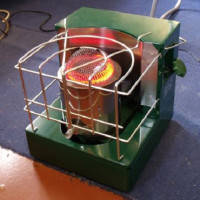 DIY miracle oven for a garage in a diesel fuel: step-by-step instructions for the construction
DIY miracle oven for a garage in a diesel fuel: step-by-step instructions for the construction 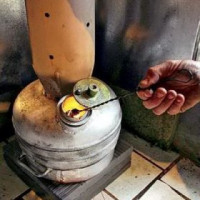 How to make a potbelly stove on waste oil with your own hands: a review of the best homemade products
How to make a potbelly stove on waste oil with your own hands: a review of the best homemade products 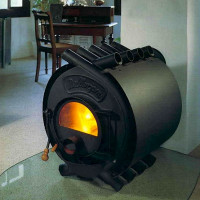 How to make a Buleryan oven with your own hands: step-by-step instructions on how to make
How to make a Buleryan oven with your own hands: step-by-step instructions on how to make 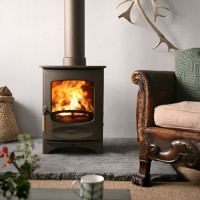 Wood-burning heating stoves for summer cottage: TOP-12 + tips for choosing equipment
Wood-burning heating stoves for summer cottage: TOP-12 + tips for choosing equipment  How much does it cost to connect gas to a private house: the price of organizing gas supply
How much does it cost to connect gas to a private house: the price of organizing gas supply  The best washing machines with dryer: model rating and customer tips
The best washing machines with dryer: model rating and customer tips  What is the color temperature of light and the nuances of choosing the temperature of the lamps to suit your needs
What is the color temperature of light and the nuances of choosing the temperature of the lamps to suit your needs  Replacement of a geyser in an apartment: replacement paperwork + basic norms and requirements
Replacement of a geyser in an apartment: replacement paperwork + basic norms and requirements
The use of a potbelly stove under normal conditions is, indeed, not entirely advisable. But I would recommend connecting the furnace to a water circuit. It is due to this combination that it will be possible to warm up the premises much better. Moreover, the heat throughout the house will be distributed more evenly. As a result, the efficiency of your stove will increase significantly.Plus, it’s better to use solid fuel - it is usually easier to get it.
Home-made stove stoves are the lot of garages and small garden and country houses. They occupy their niche and are quite appropriate in it. Their heat transfer is enough for heating compact rooms even without additional lotions, in the form of a water circuit, etc. Improvements that will save fuel and reduce the frequency of its laying will soon be in demand here.
After reading it seems that making a stove with your own hands is a simple matter. In reality, this is not quite so. A lot of different nuances, the non-observance of which will not allow the wood to burn correctly, will not create the correct draft. It is useless to talk about them; everything is known only by experience. So, if there is a desire with opportunities, then be patient and experiment in creating your furnace monster. If you do not have enough patience, then it’s better to go to the store - save both time and nerves.
You saw the prices for potbelly stoves? It feels like a solid fuel boiler is selling.